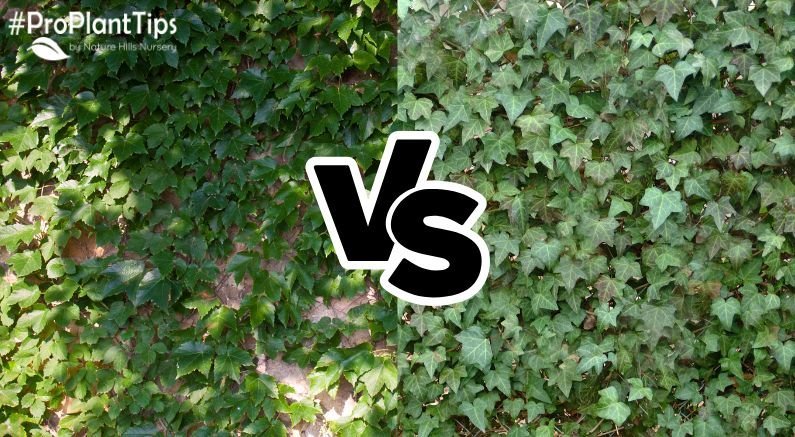
Boston Ivy and English Ivy are two of the most popular fast-growing climbing or groundcover plants used in landscaping! Both are stunning ornamental vines for covering walls, fences, retaining walls, trellises, and even trailing from hanging baskets.
While they share a similar use in the garden, Boston Ivy and English Ivy are quite different in appearance, care needs, and behavior. Knowing these differences helps gardeners choose the right vining perennial for their landscape.
- Quick Overview: Boston Ivy vs English Ivy
- All About Boston Ivy
- All About English Ivy
- Ivy Care & Maintenance
- Happy Ivy Vines!
Quick Overview: Boston Ivy vs English Ivy
Both types of Ivy are excellent for transforming outdoor spaces with lush greenery. Boston Ivy offers brilliant fall color and bird-friendly berries, while English Ivy provides evergreen coverage and timeless charm. But there's a place for everything - and everything in its place - when deciding which of these hardy climbing plants will suit your garden best.
All About Boston Ivy

The Boston Ivy (Parthenocissus tricuspidata) is a hardy deciduous vine in the grape family. Native to eastern Asia - Korea, Japan, and northern and eastern China - this ornamental plant is also called Grape Ivy, Japanese Ivy, or Japanese Creeper. Though unrelated to true Ivies, Boston Ivy is beloved for its glossy foliage and brilliant autumn display.
Boston Ivy is a remarkably fast-growing vine with tendrils and suction cup-like feet that cling easily to rock, brick, and metal siding. Unlike Virginia Creeper, it is less difficult to remove, but should not be planted on wood or shingle siding where it may pull off paint or material. Gardeners also appreciate how easy it is to grow and care for, needing very little once established.
Boston Ivy Identification & Characteristics
Boston Ivy foliage is large, three-lobed, and deep green with reddish stems, often confused with Poison Ivy when young. In fall, leaves turn scarlet to deep red, creating one of the most stunning displays among ornamental vines. In mild climates, it can remain semi-evergreen. Spring brings greenish-white flowers buzzing with pollinators, followed by small black berries for birds. Its dense foliage also provides shelter for nesting.
Boston Ivy Key Features:
- Fast-growing vine for walls, fences, and trellises
- Cold-hardy in USDA zones 4-8
- Full sun to partial shade
- Drought-tolerant once established
- Brilliant fall color
- Pollinator flowers and bird-friendly berries
- Insulates and shades hot walls
- Mature size: 30-50 ft tall, 5-10 ft spread
The Robusta Boston Ivy is even more cold-hardy, thriving in zones 3-7 with red-orange fall color. Boston Ivy is deer-resistant, adaptable to most soils, and requires very little care once established.
All About English Ivy
English Ivy (Hedera helix) is a broad-leaved evergreen perennial vine native to Europe, Western Asia, and Northern Africa. Also called Common Ivy or European Ivy, this historic ornamental plant has covered castles, cottages, and Ivy League buildings for centuries! Its trailing vines are equally useful as living mulch, groundcover, and houseplants for air purification.
English Ivy grows vigorously in both sun and shade across USDA zones 4-9. It is prized as a groundcover under trees, a fast-growing vine for vertical surfaces, or a lush spiller in hanging baskets and containers. Indoors, smaller-leaved cultivars thrive as topiaries or hanging houseplants, improving air quality.
English Ivy Identification & Characteristics

The fan-shaped, shallowly lobed leaves are deep green with a subtle sheen. Alternate growth patterns and hairy mature vines make them easy to identify. Clusters of greenish-yellow flowers attract pollinators, followed by purple-black berries enjoyed by birds. Dense growth creates a thick canopy that suppresses weeds effectively.
English Ivy Key Features:
- Mature height: 20-60 ft
- Mature spread: 3-30 ft
- Cold-hardy and heat-tolerant
- Evergreen year-round foliage
- Root hairs cling to many surfaces
- Pollinator and bird-friendly
- Adaptable groundcover or climbing vine
English Ivy prefers rich, well-drained soil but adapts easily. It requires moderate watering and benefits from mulch in cold climates. Trim regularly to manage the spread. In northern zones, plant in a protected area to prevent winter burn. The Thorndale English Ivy is a darker-leaved variety for zones 5-11 that tolerates heat beautifully.
Ivy Care & Maintenance

Both Boston Ivy and English Ivy thrive in well-drained soil with consistent watering during establishment. Plant 18-24 inches apart for quick wall coverage, or 2-4 feet apart for slower, less aggressive growth. Arborist Mulch conserves moisture and protects roots in winter. Fertilizer is optional, but a light dose of all-purpose fertilizer in spring can boost vigor.
Care Requirements:
- Boston Ivy grows best in full sun, tolerates part shade
- English Ivy tolerates full sun or shade, prefers rich soil
- Provide moderate, regular water until established. Use the Finger Test
- Mulch to retain moisture and insulate roots
- Prune in winter or early spring to control spread
Pruning Ivy Vines
Pruning is the only major chore! For Boston Ivy, prune in winter while dormant, cutting back no more than one-third at a time. For English Ivy, trim anytime during the year to keep growth in check, especially around doors, windows, and gutters. Regular pruning rejuvenates vines and prevents them from spreading where they shouldn't.
Happy Ivy Vines!
Boston Ivy and English Ivy each bring their own magic to the garden. One offers fiery fall color and bird-friendly berries, while the other gives evergreen coverage and timeless elegance. Both vines are versatile, hardy, and low-maintenance additions to any landscape. Cover walls, fences, trellises, or create lush groundcover with these iconic climbing plants!
Discover more ornamental vines at NatureHills.com and find the perfect Boston Ivy or English Ivy variety to transform your landscape today!
Happy Planting!


